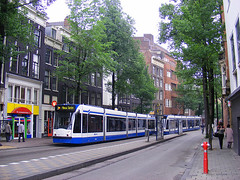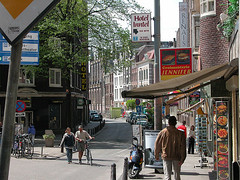Amsterdam's example for low-carbon transport

Posted July 25, 2008 at 10:25PM
 A couple of weeks ago, syndicated columnist and keen observer of community issues Neal Peirce published a very interesting column on the transportation features of Amsterdam. Fewer than half of trips taken within Amsterdam are by car, which stands in startling contrast to America’s staggering 87 percent share (finally beginning to decline) for commuting; the US share passes 90 percent when non-work trips are included.
A couple of weeks ago, syndicated columnist and keen observer of community issues Neal Peirce published a very interesting column on the transportation features of Amsterdam. Fewer than half of trips taken within Amsterdam are by car, which stands in startling contrast to America’s staggering 87 percent share (finally beginning to decline) for commuting; the US share passes 90 percent when non-work trips are included.
Bicycling counts for an amazing 37 percent of all Amsterdam transport. As Neal writes:
“So what's the Amsterdam game plan? For decades it's been to nurture the ‘compact city,’ slowing a middle-class exodus and preserving the open landscape by dense development, recycling old industrial areas and intermingling uses. Reducing auto use -- now just 41 percent of trips compared to 90 percent-plus in most U.S. cities -- is the heart of the plan.
“Helped along by the Netherlands' high gas taxes (per gallon costs are now over $9), the Amsterdam approach not only cuts energy use but provides a starting point for dramatic carbon reduction. But its genius, so rarely discussed in America, is smart land use and curbing the auto use that so easily overwhelms modern world cities.
“Example: Thousands of new housing units have recently been built on harbor islands on Amsterdam's northern flank. But the city obliged the private developers to finance a five-mile stretch of new tramline to be opened ahead of the new housing so that residents wouldn't become accustomed to car commuting.
“The imaginative, compact, transit-centered city isn't just an Amsterdam goal. In Arnhem, a principal city on the Netherlands' eastern flank, over 1 billion euros are being invested in a massive new central train, local and regional bus transit center with major new office buildings, 150 units of housing, large parking garages, substantial retail and cafes. Nearby auto lanes were put underground just to keep the new station area free for unfettered public transit.
“Why all this bother? ‘We're on the high-speed rail line from Amsterdam to Frankfurt,’ explains Gert Zwaal, Arnhem's director of development strategy.
The city is bordered by an exquisite green setting of natural wood and heather areas that can't be violated. And even if rail is expensive, notes Zwaal, ‘there's never a way to accommodate -- or build the roads -- for everyone in private cars.’”
Neal believes that the Dutch example could teach the US a lot as we rethink our transportation and community-building options for a 21st century of high energy prices and necessary carbon-reduction. And I believe he’s right. For the whole column, go here.
Me, I’ve never been to Amsterdam, except to their airport, which I remember as pretty wonderful as big airports go. But now I have another one to add to the long list of reasons why I want to go. Since that isn’t going to happen soon, below I treat you to a short slide show of images of street life in Amsterdam. Several of those, as well as one above, are from the excellent photographer Mor (bcnbits). I love his work.
Below the slide show is a video explaining why Amsterdam is the cycling capital of the world. It doesn’t hurt that it’s completely flat!
All slide show images are by Mor (bcnbits) except for the one of bicycle parking, which is by slice/Adam Kuban. The yellow bike photo accompanying the text is by DutchAmsterdam.nl: Tourist Guide to Amsterdam. Other credits are as indicated with the photos.

